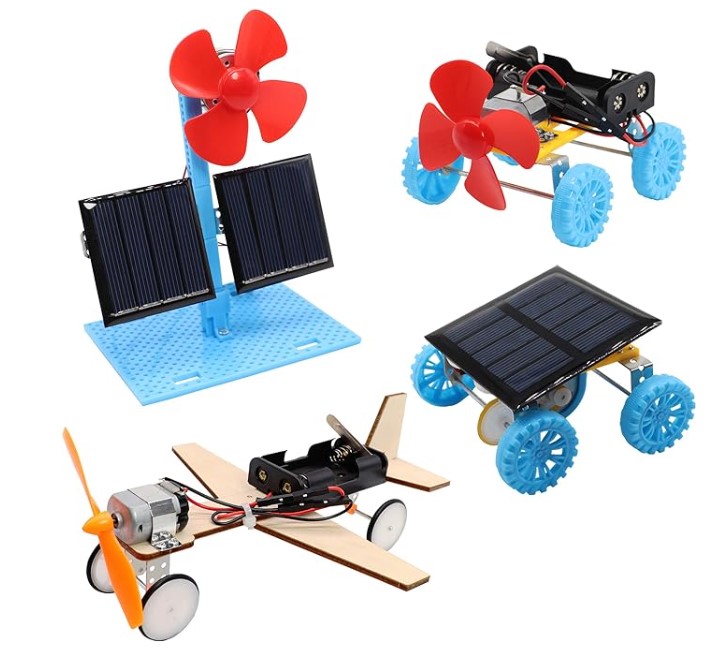Solar-powered toys are a great option for parents looking to nurture their child’s interest in STEM (Science, Technology, Engineering, and Math) through engaging play. These toys tap into the power of the sun to get moving, and in the process, teach kids valuable lessons about renewable energy and environmental responsibility.
The sun brings us about 173,000 terawatts of energy every second, which is why there is a massive push to directly harness this energy. The industry is growing and now is a great time to get your kids interested in this field.
In this article, we’ll explore the world of solar energy and start a hands-on adventure to build your very own, child friendly, solar-powered devices! And who knows, one day they might be leading this upcoming industry.

Harnessing the Sun’s Power: What is Solar Energy?
Solar energy is the radiant energy emitted by the sun. It travels through space in the form of electromagnetic waves, reaching Earth in just eight minutes. This constant stream of energy holds a massive amount of potential. With the help of technology, we can convert it into electricity for our power needs.
Why Choose Solar Energy?
There are many reasons why solar energy is becoming increasingly popular:
- Renewable: Unlike fossil fuels like coal and oil, which are finite resources, solar energy is constantly replenished by the sun. Making it sustainable for the long term.
- Clean: Solar energy production doesn’t release harmful emissions or pollutants.
- Versatile: Solar energy can be used for all our power needs.
- Cost-effective: The cost of solar technology has significantly decreased in recent years, making it a more accessible and cost-competitive option.
How Does Solar Energy Work?

There are two main ways to convert solar energy into usable electricity:
- Photovoltaic (PV) cells: These are what make up solar panels. When sunlight hits a PV cell, it creates an electric current.
- Concentrated Solar Power (CSP): CSP uses mirrors to concentrate sunlight onto a receiver, which heats water. The water turns into steam which drives a turbine and generates electricity.
Building Your Own Solar Adventure!
Now, let’s put theory into practice and embark on a fun and educational adventure! The easiest, low cost, and reliable way to get your kid excited about solar is a kit.
This kit is perfect for young minds curious about science and technology.
- Hands-on learning: Building the solar rover from scratch is rewarding and gives valuable experience. The building process allows for a better understanding about solar energy, electricity, and mechanics.
- Fun and engaging: The process of assembling the rover is interactive and engaging, keeping young minds excited about science and discovery.
- Reusable and affordable: The kit uses recyclable materials, promoting eco-friendly practices, and is offered at an accessible price point.
The assembly process is straight forward and step-by-step, transforming a simple box of parts into a functional solar-powered car. I will add that it’s pretty incredible watching something you built zoom around, powered by the suns clean, renewable energy.
Beyond the Rover. Exploring Solar Power in your own home.
Building your solar rover is just the beginning of your exploration! There are many other exciting projects you can take on using solar energy without kits.
Building a solar oven: This was a fun, super simple, experiment to do at home!
- Materials:
- Cardboard box (pizza boxes will work!)
- Aluminum foil
- Black construction paper
- Plastic wrap or clear glass sheet
- Tape
- Scissors or a box cutter
- Wooden stick or skewer
- Construction:
- Create the flap: Cut a flap in the lid of the box, leaving a 1-inch border. Cut away any unnecessary sections.
- Insulate and reflect: Line the inside of the box with aluminum foil to reflect sunlight. Cover the base with black construction paper to absorb heat.
- Make a window: Stretch plastic wrap or secure the clear glass sheet over the flap opening, creating an airtight seal with tape.
- Prop the flap: Use the stick or skewer to prop open the flap at an angle to catch the sunlight.
- How it works: The sunlight passes through the plastic/glass window but can’t escape, resulting in heat build-up inside the box. This creates a mini-oven perfect for cooking small snacks or melting s’mores!
Dancing Sunflower: Another super simple project to be powered by the sun.
- Materials:
- Cardboard
- Markers, crayons, or paint
- Straw
- Aluminum foil
- Small solar panel (2V or higher)
- Mini DC motor (can be found online or in electronics stores)
- Craft paper or construction paper (optional)
- Glue stick and tape
- Construction:
- Create the sunflower: Draw and color a large sunflower on cardboard or cut out shapes from construction paper. Glue or tape the pieces onto a sturdy cardboard base.
- Make the head spin: Cut a small hole in the center of the sunflower head. On the cardboard base, glue the straw upright, passing it through the hole in the sunflower head.
- Attach the solar panel: Secure the mini solar panel flat on the cardboard base, facing towards the sun.
- Connect the motor: Following the motor’s instructions (usually with wires and small alligator clips), connect the positive and negative terminals to the solar panel’s corresponding points.
- Attach the motor to the straw: Fix the motor upright on the base using tape or glue, ensuring the motor shaft spins freely and connects with the bottom of the straw.
- How it works: Under sunlight, the solar panel converts light into electricity, powering the motor. The motor spins the straw, causing the sunflower head to dance and sway!
The possibilities are endless! As your kids delve deeper into the world of solar energy, they’ll not only discover its potential but also contribute to building a more sustainable future for our planet!

